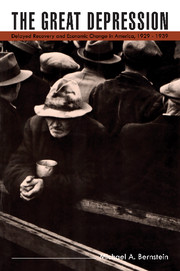Book contents
- Frontmatter
- Contents
- List of tables
- List of figures
- Editors' preface
- Preface
- Introduction: The puzzle of the 1930s
- 1 Long-term economic growth and the problem of recovery in the United States, 1929–39
- 2 The transformation of American industry in the interwar period
- 3 A reassessment of investment failure in the interwar economy
- 4 Technical change during the interwar years
- 5 The effective demand problem of the interwar period. I: Cyclical and structural unemployment
- 6 The effective demand problem of the interwar period. II: Cyclical and secular changes in final demand
- 7 New Deal economic policy and the problem of recovery
- 8 Contemporary economic problems in historical perspective
- Bibliography
- Index
Preface
Published online by Cambridge University Press: 06 July 2010
- Frontmatter
- Contents
- List of tables
- List of figures
- Editors' preface
- Preface
- Introduction: The puzzle of the 1930s
- 1 Long-term economic growth and the problem of recovery in the United States, 1929–39
- 2 The transformation of American industry in the interwar period
- 3 A reassessment of investment failure in the interwar economy
- 4 Technical change during the interwar years
- 5 The effective demand problem of the interwar period. I: Cyclical and structural unemployment
- 6 The effective demand problem of the interwar period. II: Cyclical and secular changes in final demand
- 7 New Deal economic policy and the problem of recovery
- 8 Contemporary economic problems in historical perspective
- Bibliography
- Index
Summary
This book seeks to explain why the American depression of the 1930s lasted so long. It is intended for a varied audience. I have studied a system, a structure of economic life and how it came to grief in the time between the world wars. I have said little of individuals, their thoughts and feelings, their styles of life, or their perceptions of the world around them. I have examined the past with a view to answering certain questions about how modern economies behave. I have tried to avoid questions history cannot answer by focusing on what actually happened.
The economic collapse of the 1930s, inducing major changes in the role of government in American life, and preceding a war that dramatically altered the nation's role in world affairs, has been examined in a wide variety of ways. A study that explicitly offers an explanation of the depression's length should contribute to the historian's argument that in the thirties exceptional economic conditions transformed the country's political and social framework. Moreover, it should afford the economist some useful insights regarding business cycles and unemployment. Of course, the reader will ultimately have to judge to what extent these claims are true.
Economic and historical pertinence notwithstanding, I have been reluctant to engage in much normative or predictive discussion. With the exception of the last two chapters, I have avoided debates concerning policy.
- Type
- Chapter
- Information
- The Great DepressionDelayed Recovery and Economic Change in America, 1929–1939, pp. xv - xviiiPublisher: Cambridge University PressPrint publication year: 1987

